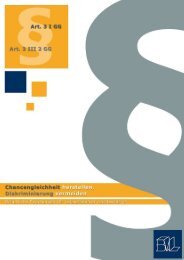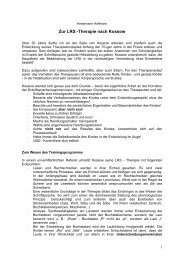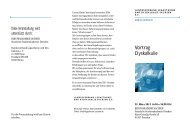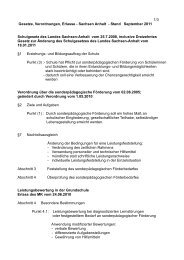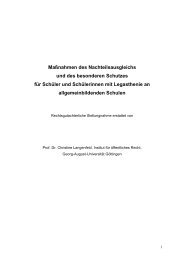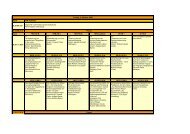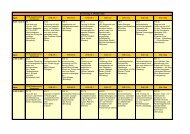Abstractband zum 16. Kongress des Bundesverbandes Legasthenie
Abstractband zum 16. Kongress des Bundesverbandes Legasthenie
Abstractband zum 16. Kongress des Bundesverbandes Legasthenie
Erfolgreiche ePaper selbst erstellen
Machen Sie aus Ihren PDF Publikationen ein blätterbares Flipbook mit unserer einzigartigen Google optimierten e-Paper Software.
<strong>16.</strong> <strong>Kongress</strong> <strong>des</strong> Bun<strong>des</strong>verban<strong>des</strong> <strong>Legasthenie</strong> <strong>Abstractband</strong><br />
The cognitive neuroscience of typical and atypical development of<br />
numerical cognition<br />
Daniel Ansari<br />
University of Western Ontario, Department of Psychology, London, Canada<br />
How are numbers represented in the human brain? Recent functional brain imaging<br />
studies are converging to suggest that the adult parietal cortex plays a crucial role in<br />
number representation and processing. In contrast, little is known about how representations<br />
of numerical magnitude change over developmental time. Furthermore, <strong>des</strong>pite the<br />
fact that a large number of children have Developmental Dyscalculia and mathematical<br />
difficulties, we currently lack detailed insights into the neurocognitive basis of atypical<br />
number development.<br />
To address these outstanding issues, I will present data from behavioral and brain imaging<br />
investigations into the developmental trajectories of both symbolic and non-symbolic<br />
numerical magnitude representation. I will discuss data from both typically developing<br />
children and those who present with Developmental Dyscalculia. These data suggest<br />
that the parietal cortex becomes specialized for the representation and processing of<br />
number over developmental time and that this age-related process is disrupted in children<br />
with Developmental Dyscalculia.<br />
Against the background of these data, I will argue that it is crucial to consider developmental<br />
changes in the neurocognitive mechanisms underlying numerical magnitude<br />
representation in order to gain greater insights into how children develop mathematical<br />
skills and how these processes break down in children who have mathematical difficulties.<br />
Finally, I will consider the implications of these data for the understanding of how, early<br />
developing, numerical magnitude representations may constrain the acquisition of<br />
higher-level number skills as well as the implications of the results for the diagnosis and<br />
remediation of mathematical difficulties.<br />
Korrespondenzautor:<br />
Daniel Ansari<br />
daniel.ansari@uwo.ca<br />
Wie erlernen Kinder orthographisch richtig zu schreiben?<br />
Carolin Arnoldi, Gerd Schulte-Körne<br />
Klinik und Poliklinik für Kinder- und Jugendpsychiatrie, Psychosomatik und Psychotherapie, Klinikum der<br />
Universität München, München, Deutschland<br />
In einem von der Deutschen Forschungsgemeinschaft geförderten Projekt wurde das<br />
orthographische Lernen bei Kindern mit schwachen und starken Rechtschreibleistungen<br />
untersucht.<br />
Theoretische Grundlage ist die Annahme, dass für das Erlernen einer korrekten Rechtschreibung<br />
implizites, d.h. nicht bewusst steuerbares Lernen von Buchstabenhäufigkeiten<br />
von großer Bedeutung ist (Cassar & Treiman, 1997). In zwei Pilotstudien soll die<br />
3



